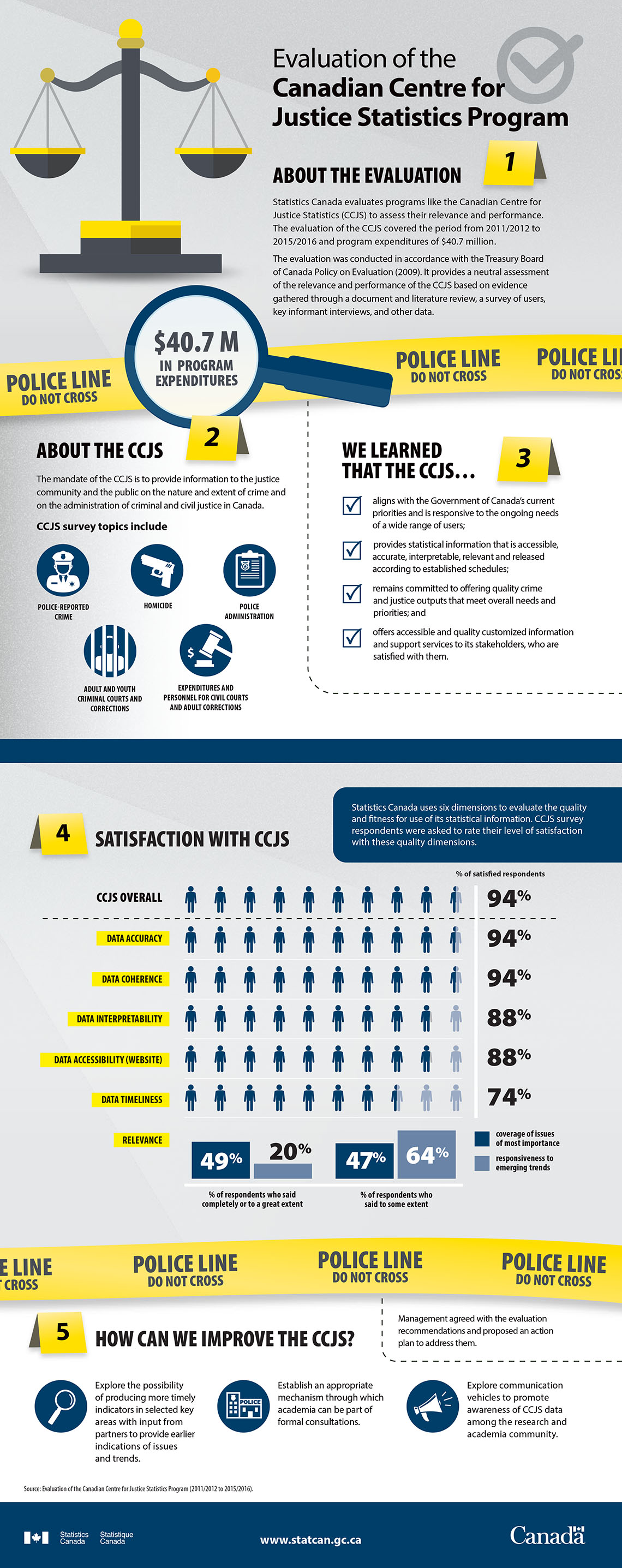
Description - Evaluation of the Canadian Centre for Justice Statistics Program - Information Sheet
Evaluation of the Canadian Centre for Justice Statistics Program - Information Sheet
1: About the evaluation
Statistics Canada evaluates programs like the Canadian Centre for Justice Statistics (CCJS) to assess their relevance and performance. The evaluation of the CCJS covered the period from 2011/2012 to 2015/2016 and program expenditures of $40.7 million.
The evaluation was conducted in accordance with the Treasury Board of Canada Policy on Evaluation (2009). It provides a neutral assessment of the relevance and performance of the CCJS based on evidence gathered through a document and literature review, a survey of users, key informant interviews, and other data.
A yellow ribbon crosses the page with the text: "Police Line Do Not Cross"
A magnifying glass appears on the yellow ribbon with the text: $40.7 M in program expenditures
2: About the CCJS
The mandate of the CCJS is to provide information to the justice community and the public on the nature and extent of crime and on the administration of criminal and civil justice in Canada.
CCJS survey topics include
- police-reported crime
- homicide
- police administration
- adult and youth criminal courts and corrections
- expenditures and personnel for civil courts and adult corrections.
3: We learned that the CCJS…
- aligns with the Government of Canada's current priorities and is responsive to the ongoing needs of a wide range of users.
- provides statistical information that is accessible, accurate, interpretable, relevant and released according to established schedules.
- remains committed to offering quality crime and justice outputs that meet overall needs and priorities.
- offers accessibility and quality of customized information and support services to its stakeholders, who are satisfied with them.
4: Satisfaction with CCJS
Statistics Canada uses six dimensions to evaluate the quality and fitness for use of its statistical information. CCJS survey respondents were asked to rate their level of satisfaction with these quality dimensions.
- CCJS overall: 94% of satisfied respondents
- Data accuracy: 94% of satisfied respondents
- Data coherence: 94% of satisfied respondents
- Data interpretability: 88% of satisfied respondents
- Data accessibility (website): 88% of satisfied respondents
- Data timeliness: 74% of satisfied respondents
- Relevance - coverage of issues of most importance: 49% of respondents who said completely or to a great extent and 47% of respondents who said to some extent
- Relevance - responsiveness to emerging trends: 20% of respondents who said completely or to a great extent and 64% of respondents who said to some extent
A yellow ribbon crosses the page with the text: "Police Line Do Not Cross"
5: How can we improve the CCJS?
- Explore the possibility of producing more timely indicators in key selected areas with input from partners to provide earlier indications of issues and trends.
- Establish an appropriate mechanism through which academia can be part of formal consultations.
- Explore communication vehicles to promote awareness of CCJS data among the research and academia community.
Management agreed with the evaluation recommendations and proposed an action plan to address them.
Source: Evaluation of the Canadian Centre for Justice Statistics Program (2011/2012 to 2015/2016).